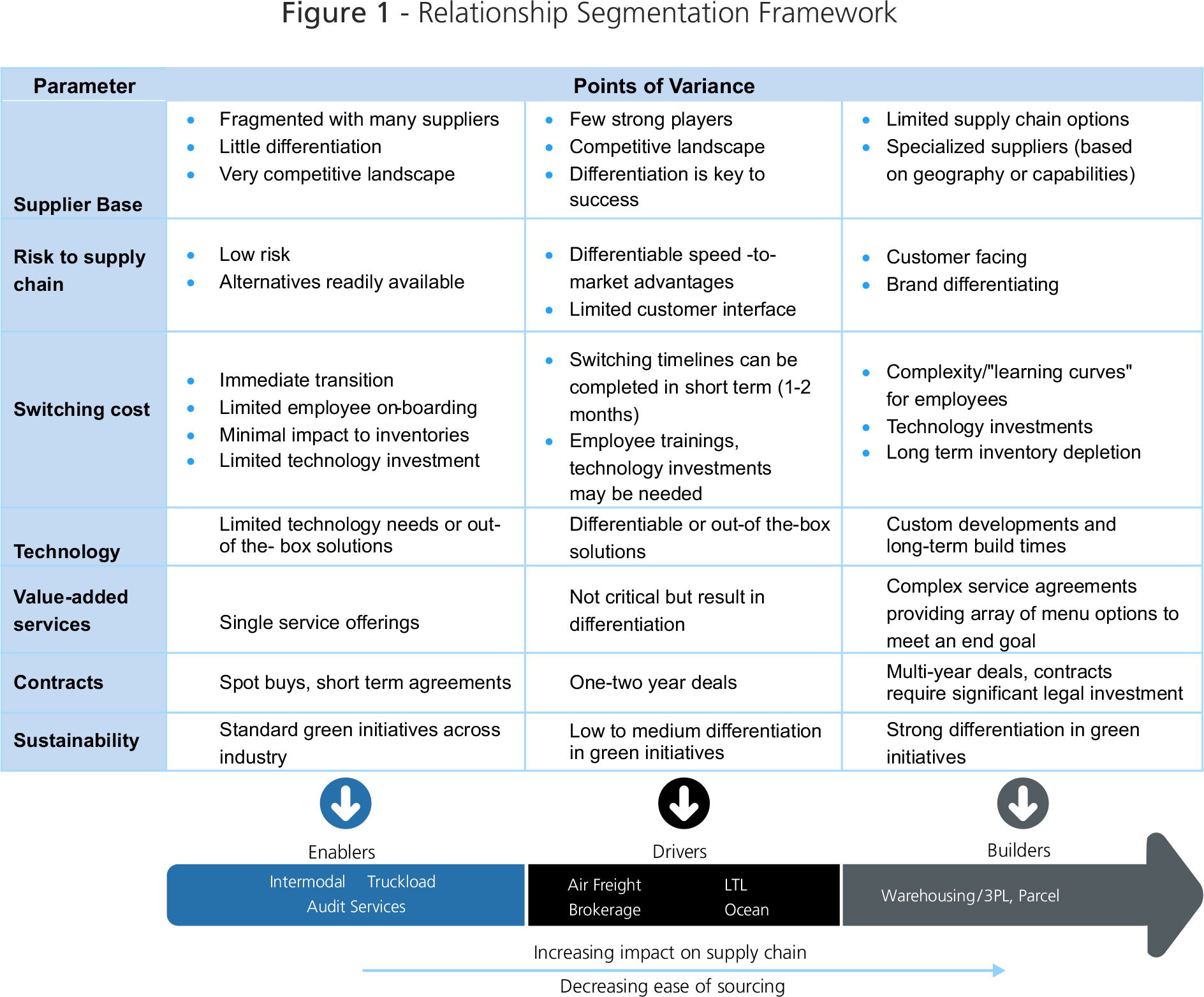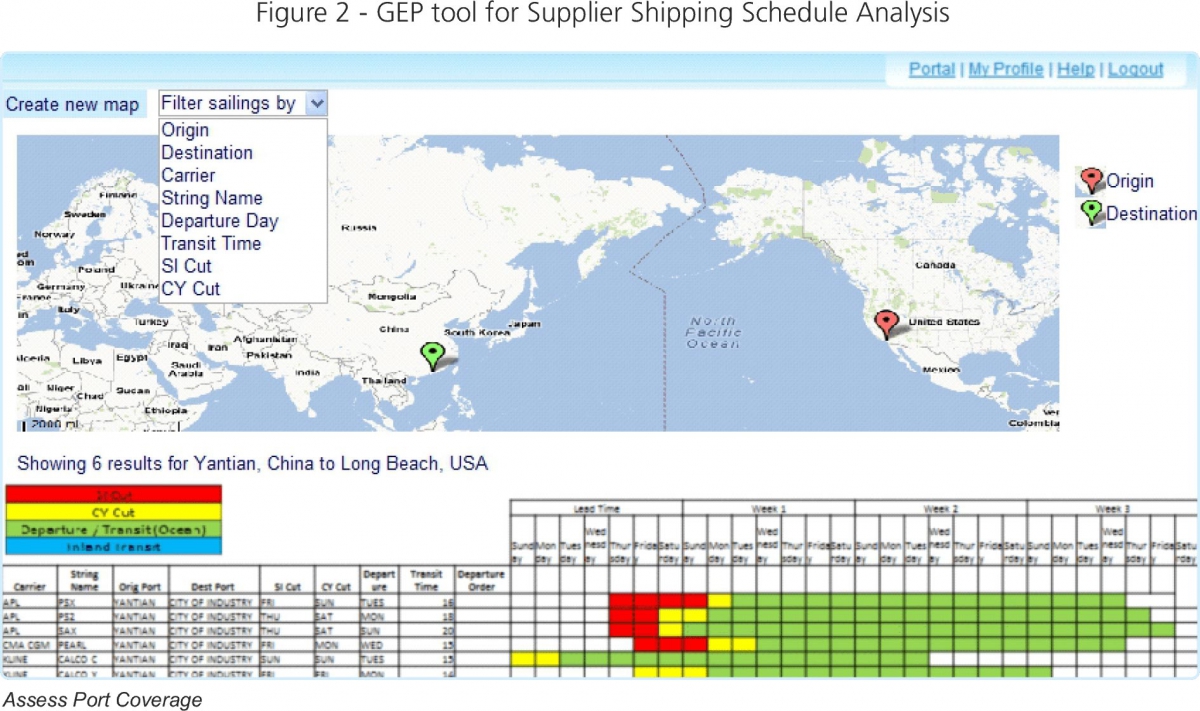Supply Chain – The 'Speed to Market' Agenda
In the Apparel, Footwear and Accessories (AFA) industry, the faster you can bring the product to the market, the more competitive your company is likely to be. The importance of speed-to-market has made it essential for AFA companies to maintain an agile supply chain. In addition, the increasing trend of a greater number of fashion seasons, high SKU proliferation, global sourcing and manufacturing have heightened pressure on the supply chains across the AFA industry.
Given the diverse and large supplier base, procurement teams are often faced with the challenge of utilizing their limited time and resources effectively in order to maintain relationships. It becomes imperative that procurement professionals channel their energy and use a scalable approach to supply chain sourcing and management. The Relationship Segmentation Framework, as depicted in Figure 1, enables procurement professionals to achieve cost savings.
Relationship Segmentation Framework
The Relationship Segmentation Framework provides the guidelines for classifying suppliers amongst three different segments – Enablers, Drivers and Builders – based on:
- Impact on supply chain
- Ease of sourcing
These two criteria can be broken down into measurable parameters: supplier base or alternatives available, risks to supply chain, switching cost, technology enhancements, value-added services, contracts and sustainability.
Classifying suppliers into three segments based on these parameters should be procurement's first step in developing the supplier engagement strategy. Figure 1 shows a segmentation that is typical of most AFA companies.

To understand the segmentation better, let us compare parcel and less than truckload (LTL), which are the two modes most commonly used for light-weight shipments. There are only a handful of parcel suppliers with national coverage in most countries and the number of international parcel carriers is even more limited. Parcel, as it relates to AFA companies, is primarily used to ship products to customers, meaning that a disruption or delay in the supply chain could lead to a huge loss of face with customers. Additionally, there are several value-added services that parcel- suppliers provide to their key customers, such as late pickups, early drop-offs, weekend deliveries, address-checking and corrections prior to shipping.
In contrast, the LTL supply base is extensive, with hundreds of options at the national as well as regional level. LTL is typically sought to ship raw materials from factories to distribution centers or from distribution centers to retail stores; therefore, the implications of a broken supply chain are not as disastrous as in the case of the parcel service. Value- added services offered by LTL providers are also somewhat limited; vehicle tracking, industry certifications are some examples. On the other hand, due to these differences, parcel suppliers should be treated as Builders, while LTL carriers would fall into the Driver segment.
Supplier Management Guidelines
Enablers
Truckload, intermodal, shuttle and audit service providers are classified in this segment due to the plethora of suppliers available in the competitive landscape, with low switching cost and low risk to the supply chain. For example, a truckload supplier moving pallets of shoes from an AFA firm's distribution center to a department store's consolidation center. There are thousands of companies in the US alone, capable of providing logistics services in this industry, for the necessities are bare and call for only a truck and a driver. However, there may be exceptions. For instance, a truckload service provider, who fills a niche on a hard to service lane or moves specialty products such as leathers, chemicals or other raw materials, may-be placed in the Driver segment as opposed to the Enabler segment.
Sourcing
As described in Figure 1, even though Enablers offer standard non-differentiable services with low risk to the supply chain, it is important for the procurement department to review these categories once every year or two. Procurement should be determining whether the category calls for a sourcing exercise based on supply and demand as well as factors such as fuel prices in the industry. Bear in mind that this varies across categories and is time-sensitive due to the everchanging nature of business needs, which ultimately can lead to a change in lane profiles.
Casting a wide net in a bid for these services is critical for achieving potential cost-savings benefits. For instance, a truckload service provider may have a backhaul lane corresponding to a lane in your profile, which could lead to network optimization at the service provider's end and lower rates for your supply chain.
Even though this industry is somewhat commoditized due to the large number of players, there is significant differentiation across suppliers in terms of service levels and value-added services. On-time delivery performance, technology offerings such as availability of vehicle tracking devices, reaction time to unexpected customer requests, and certifications can be pressing reasons for preference of one supplier over another.
Selecting the right partner with a competitive rate and excellent service levels and value-added services in these seemingly small categories can help procurement gain the credibility of the Logistics department and open the doors for involvement in the Driver and Builder segments, which are otherwise characterized by strong ties with incumbent suppliers.
Supplier Management
Supplier relationships in this segment are more transactional in nature and require limited relationship management. Once contracts or rate cards are negotiated and implemented, annual or bi-annual reviews are suggested for the purpose of ongoing category management.
Drivers
Suppliers offering airfreight, less than truckload, and ocean freight services differentiate themselves by means of their diverse offerings. Regional coverage, transit times, container types, technology, and customer service are typical differentiators in these industries. Despite there being hundreds of players in each of these industries, more often than not, only a handful will best suit the business requirements of an AFA company. As such, these suppliers are placed in the Driver segment.
For example, an AFA company with its distribution center in Michigan will prefer collaborating with an ocean freight carrier whose ports align more closely with its production or distribution facilities for significant cost savings. To continue with the example of ocean freight carriers, the effort of switching their suppliers could take one or two months involving contract negotiations, security assessments, training to shippers and consignees, and changes at the end of the company's third-party Logistics providers. Due to these differentiable offerings and medium to high transition costs, ocean freight is placed in the Driver segment.
Sourcing
In order to gain the maximum value from these relationships, procurement must ensure that negotiations with these suppliers are not limited to target pricing discussions. Fleet commitment and pricing guarantees through the year should be addressed and compared. For instance, when negotiating with ocean freight carriers, Procurement should discuss ability to provide large size containers (which are typically more cost-effective) and ability to waive general rate increases, peak season surcharges, and accessorial charges to gain maximum value from supplier relationships.
Procurement must conduct rigorous due diligence with respect to the suppliers shipping schedule (departure days, transit times, cutoffs for document submission), disaster recovery mechanisms, port contingencies and weekend deliveries (if required) to ensure the supply chain is agile and robust. Bids for services in this segment should be conducted annually unless the supply market is unfavorable. It is also highly advisable to select primary and secondary carriers to minimize risk and improve flexibility.
Supplier Management
Formal business reviews covering reporting of key performance metrics should be conducted annually or bi-annually. In addition, these relationships should be assessed on an ongoing basis. Since these suppliers impact the supply chain most through their speed-tomarket, any lapses in performance in that area should be escalated immediately.
Builders
Suppliers in this segment are supply chain partners of an AFA firm and pivotal in driving brand differentiation and customer satisfaction. These suppliers align their services to the AFA company's supply chain strategy, while remaining nimble to adapt to growth and market fluctuations. Warehouse/ Third-party Logistics (3PL) and parcel suppliers are categorized under this segment due to the high supply chain impact these services have, especially in the AFA industry.
Let's examine the case of an AFA firm wanting to establish a new distribution center, with reference to our segmentation (Figure 1). The availability of capacity at a suitable location and scope for expansion frequently limits the number of supplier options. Additionally, the initial set-up and transition cost make supplier switching costs extremely high. Since warehousing operations in the AFA industry call for complex value-added services, there are learning curves to differentiate suppliers.
In addition to the aforementioned, aspects such as IT capabilities, assets held, breadth and depth of logistics portfolio, and best practices followed, all have a huge impact on the quality of service a potential supplier can offer. Following a similar logic, generally a high degree of mutual commitment would be needed from both parties, especially around contractual obligations. Procurement professionals should have a long-term view of business growth and strategy and must perform rigorous due diligence while managing supplier relationships in this segment.
Sourcing
While sourcing suppliers in this segment, procurement should ensure past experience of suppliers in handling similar product lines, as there are complex industryspecific functions and value-added services involved. An RFI exercise, followed by service portfolio presentations from suppliers, will help identify suppliers with best alignment to the company's supply chain goals and strategies. Supplier site visits should be conducted to verify operational capabilities. Site visits also provide insights into technology investments, work processes and on-ground operational and management teams set up by suppliers.
Various pricing options, including gain share models, should be explored in light of industry best practices, as well as compliance with internal cost accounting models. Defining KPIs per lead time and other service level requirements is another area that procurement should focus early on in the sourcing process.
Since contracts with these suppliers are usually long term, procurement should carefully consider future growth and supply chain scenarios. For instance, in case of a dedicated warehouse, minimum guarantees have to be set with future business considerations and must-have clauses to incentivize the AFA firm, in case of overshooting the minimum by a considerable margin.
Supplier Management
Well-managed relationships in this segment can yield huge benefits to AFA firms. While trust is paramount in such relationships, regular performance audits need to be conducted to track lapses and take remedial action.
Procurement should focus on fostering open dialogue with these suppliers as they can share useful insights into the AFA company's business practices. This can be achieved by scheduling periodic discussions between core team members of both sides to review the relationship. Since a full-blown sourcing effort is resource intensive and often prohibitive, procurement must conduct periodic benchmarking exercises to validate and ensure effective pricing.
There is usually a high degree of interdependence as these services attract significant mutual investment and involve considerable learning curves. Procurement should pay attention to such interdependencies and work with suppliers to ensure a win-win situation for both partners.
Case Study
The Challenge
Ocean freight is a category that falls in the Driver segment of the relationship segmentation model. Depending on the container sizes, port coverage and transit times offered, some of these suppliers may even fall in the Builder segment. The category involves several complexities - international supplier base, tariffs and restrictions by geography, multiple cost components, and price and capacity fluctuations due to global market conditions. Selection of suppliers in light of these complexities, compounded by hundreds of lanes in the shipping profile, varying transit times, different Minimum Quantity Commitment (MQC) requirements, and availability of different container sizes, was a challenge the Logistics department of a multi-billion-dollar player in the AFA industry faced every year.
The process of supplier evaluation was manual and intuition-based, leading to several days of pricing analysis and qualitative comparisons of every bidding cycle of a supplier. Moreover, the Logistics department had a strong preference for certain industry leaders (which come at a premium), and as a result, money was left on the table. GEP assisted the Logistics department effectively to source this $20MM category, driving savings and improving overall service levels through a systematic, but simplified assessment of suppliers and fact-based negotiations.
The Solution
GEP conducted a RFP process with over fifteen ocean freight carriers, including incumbent and new carriers. The proven process adopted by GEP helped compare suppliers based on pricing for over 100 lanes, five different container types and 5-10 different cost components within hours. Screening suppliers based on capabilities boiled down to evaluation of container capacity, shipping schedules and port coverage. Outlined below is the approach for assessing suppliers based on these parameters:
Container Capacity
At the forefront of consideration is ensuring that containers are available when needed. Most carriers will require Minimum Quantity Commitments (MQCs) when entering into contract. Container requirements from each carrier were projected and MQCs were negotiated accordingly. Agreements were reached with carriers with regard to container availability, especially during peak seasons.
The measure used by carriers to calculate capacity is typically the twenty-foot-equivalent, or TEU. However, with multiple container sizes available, from the 20' to the 53', capacity considerations were explored to determine the most cost-effective container size for each lane.
Shipping Schedules
In a fast-paced fashion season, missing the boat can mean, well, missing the boat on sales. One of the most beneficial value-adds of the GEP toolkit was the ability to provide a comprehensive understanding of the carrier's shipping schedules by port. For ports where production levels warrant more than a container per day, making sure you have coverage for each day of the week can drastically improve speed-to-market. Each season, and sometimes more than once a season, these schedules and routes are updated to reflect changes to the carrier's network optimization.
GEP secured details on not only the sailing dates, but also when containers were due in the yard (container yard cutoff, or CY cuts), lead time needed to schedule the booking (shipping info cutoff, or SI cut) and the transit times on the water. By mapping these components on a sailing schedule, GEP tools helped make the selection of primary and secondary suppliers simple.
For the supply chain team, it is not enough to assess only historic usage but you need to also be prepared for changes in the supply chain network. Changes to partner factory location, brand output, and global economic and political conditions can have a great impact on the ocean freight lanes under contract. For this reason, a carrier's capabilities to service multiple ports in a region were evaluated and contracts were established by a network of carriers to key regional ports.
In terms of cost containment, $2MM in savings was achieved by the client in one year.

Conclusion
The approach, process and tools introduced have enabled our AFA client's Logistics department to source the ocean freight category with over $3.5MM savings in the last two years.
The supplier evaluation, selection and negotiation process is now more systematic, automated and less time-consuming. With a small Logistics department overseeing the international supply chain of the organization, this was a beneficial shift from the manual and intuition-based sourcing process. The approach and tools outlined can be easily adopted by AFA companies trying to leverage supply chain categories to achieve speed-to-market while keeping costs low.

